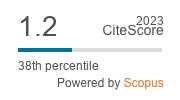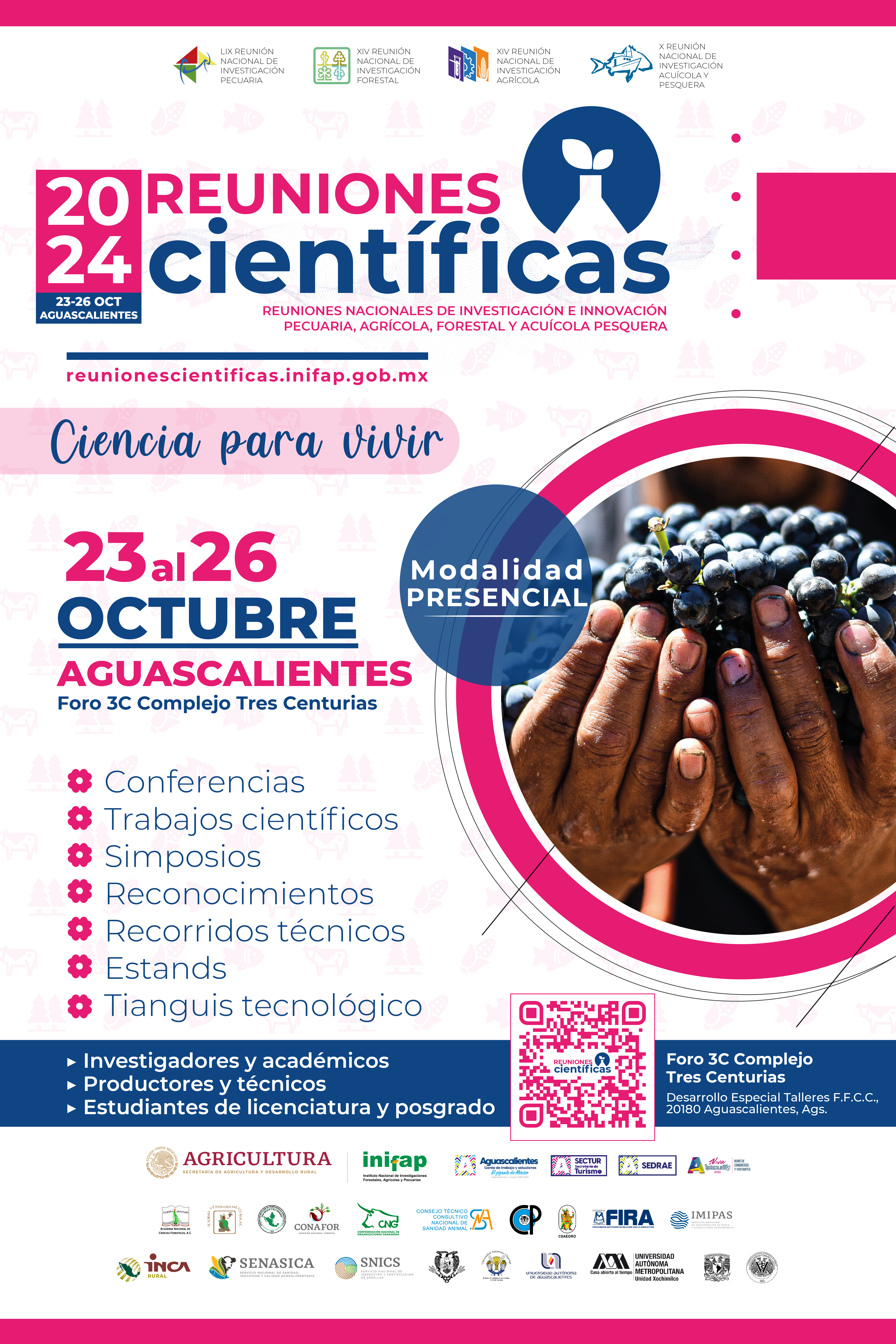Microsilages elephant grass BRS Capiaçu added with commercial microbial consortium on different days of regrowth
DOI:
https://doi.org/10.22319/rmcp.v15i1.6379Palabras clave:
Biological inputs, Pennisetum purpureum, low-quality pasturesResumen
This study aimed to evaluate whether bacterial inoculation improves the fermentative, microbiological, and chemical characteristics of silages of the elephant grass cv. BRS Capiaçu on different regrowth days. The experimental design was completely randomized and set up in a 3x2 factorial arrangement (three regrowth days, with and without inoculant), with four replications. There was a significant interaction between the regrowth days and inoculant on the pH, ammoniacal nitrogen (N-NH3), and effluent losses (EL) of the silages. Inoculation decreased the EL with the advance of regrowth days and increased the dry matter recovery index compared to the silages without inoculant. The population of molds and yeasts decreased when inoculation was adopted to the forage harvested after 85 d. There was a significant interaction between the dry matter (DM), crude protein (CP) and neutral detergent fiber corrected for ash and protein (NDFap) contents of the silages. Inoculation in the grass harvested after 85 d increased the DM contents of the silage. The highest CP contents were observed in the silages after 85 d. The NDFap contents of the grasses harvested after 110 and 135 d were higher than those of the grass harvested after 85 d. The NDFap contents of the silages without inoculant increased with the harvest age. The BRS Capiaçu forage silage harvested at 110 d demonstrated favorable performance for silage production. However, the influence of inoculant use was low for the characteristics evaluated.
Descargas
Citas
Cardoso AM, Araujo SAC, Rocha NS, Domingues FN, Azevedo JC, Pantoja LA. Elephant grass silage with the addition of crambe bran conjugated to diferente specific massa. Acta Scientiarum. Animal Sciences 2016; 38:375-382.
Retore M, Alves JP, Junior MAPO, Mendes SS. Qualidade da silagem do capim-elefante BRS Capiaçu. Dourados, MS: Embrapa Agropecuária Oeste; 2020.
Pereira AV, Lédo FJS, Machado JC. BRS Kurumi and BRS Capiaçu – New elefhant grass cultivars for grazing and cut-and-carry system. Crop Breeding and Applied Biotechnology 2017; 17:59-62.
Monção FP, Costa MAMS, Rigueira JPS, Sales ECJ, Leal DB, Silva MFP, et al. Productivity and nutritional value of BRS capiaçu grass (Pennisetum purpureum) managed at four regrowth ages in a semiarid region. Tropical Animal Health and Production 2020; 52:235-241.
Pereira AV, Oliveira JC, Ledo FJS, Diniz FH, Xavier DF, Lanes JJSN, et al. BRS Capiaçu e BRS Kurumi: Cultivo e uso. Brasília, DF: Embrapa, 2021.
Desta ST, Yuan X, Li J, Shao T. Ensiling characteristics, structural and nonstructural carbohydrate composition and enzymatic digestibility of Napier grass ensiled with additives. Bioresource technology 2016; 221:447-454.
Costa R, Silva RC, Souza ED, Vieira EM, Nascimento TSS, Alencar AP. Bagaço de cana-de-açúcar (Saccharum officinarum L.) na ensilagem do capim-elefante (Pennisetum purpureum Schum) com ou sem inoculante bacteriano. Revista Acta Kariri-Pesquisa e Desenvolvimento 2017; 2:29-36.
Shah AA, Xianjun Y, Zhihao D, Junfeng L, São T. Microbiological and chemical profiles of elephant grass inoculated with and without Lactobacillus plantarum and Pediococcus acidilactici. Archives of microbiology 2018; 200:311-328.
Cândido MJD, Gomide CAM, Alexandrino E, Gomide JA, Pereira WE. Morfofisiologia do dossel de Panicum maximum cv. Mombaça sob lotação intermitente com três períodos de descanso. Revista Brasileira de Zootecnia 2005; 34: 406-415.
Zanine AM, Santos EM, Ferreira DJ, Gomes-Pereira O. Populações microbianas e componentes nutricionais nos órgãos do capim-tanzânia antes e após a ensilagem. Semina: Ciências Agrárias 2007; 28: 143-150.
Schmidt P. Perdas fermentativas na ensilagem, parâmetros digestivos e desempenho de bovinos de corte alimentados com rações contendo silagens de cana-de-açúcar (tese de doutorado). Piracicaba, SP: Universidade de São Paulo; 2006.
Silva DJ, Queiroz AC. Análise de alimentos: métodos químicos e biológicos. 3a edição. Viçosa, MG: UFV; 2002.
Ferreira DA, Gonçalves LC, Molina LR, Castro-Neto AC, Tomich TR. Características de fermentação da silagem de cana-de-açúcar tratada com ureia, zeólita, inoculante bacteriano e inoculante bacteriano/enzimático. Arquivo Brasileiro de Medicina Veterinária e Zootecnia 2007; 59:423-433.
AOAC - Official methods of analysis. 12a edição. Washington, DC. Association of Official Analytical Chemists. 1990.
Van-Soest PJ, Robertson JB, Lewis BA. Methods for dietary fiber, neutral detergent fiber, and nonstarch polyssacharides in relation to animal nutrition. Journal of Dairy Science 1991; 74:3583-3597.
Valente TNP, Detmann E, Filho SCV, Queiroz AC, Sampaio CB, Gomes DI. Avaliação dos teores de fibra em detergente neutro em forragens, concentrados e fezes bovinas moídas em diferentes tamanhos e em sacos de diferentes tecidos. Revista Brasileira de Zootecnia 2011; 40:1148–1154.
Silva N, Junqueira VCA, Silveira NFA. Manual de métodos de análise microbiológica de alimentos. Varela, SP; 1997.
Machado FS, Rodriguez NM, Rodrigues JAS, Ribas, MN, Teixeira AM, Ribeiro Júnior GO, Velasco FO, Gonsalves FC, Guimarães Júnior R, Pereira LGR. Qualidade da silagem de híbridos de sorgo em diferentes estádios de maturação. Arquivo Brasileiro de Medicina Veterinária e Zootecnia 2012; 64: 711-720.
Kung Jr L, Stokes MR, Lin CJ. Silage aditives. In: American Society of Agronomy, Silage science and technology. Madison, WI; 2003: 305-360.
Pahlow G Muck RE, Driehuis F, Oude-Elferink SJWH, Spoelstra SF. Microbiology of ensiling. In: American Society of Agronomy, Silage science and technology. Madison, WI; 2003: 31-93.
McDonald P, Henderson AR, Heron SJE. The biochemistry of silage. 2ª edição. Marlow: Chalcomb Publications; 1991.
Bernardes TF, Souza NSS, Silva JSLP, Santos IAP, Faturi C, Domingues F. Uso de inoculante bacteriano e melaço na ensilagem de capim-elefante. Revista de Ciências Agrárias Amazonian Journal of Agricultural and Environmental Sciences 2013; 56: 173-178.
Van Soest P. Nutritional Ecology of the Ruminant. New York, EUA: Cor-nell University Press; 1994.
Church DC. The ruminal animal digestive physiology and nutrition. New Jarsey: Prentice Hall, 1988.
McGuffey RK, Schingoethe DJ. Feeding value of a high oil variety of sunflowers as silage to lactating dairy cows. Journal of Dairy Science 1980; 63: 1109-1113.
Wilson JR. Cell wall characteristics in relation to forage digestion by ruminants: review. Journal Agriculture Science 1994; 122:173-182.
Rodrigues PHM, Lopes TFT, Andrade SJT, Melotti L, Lucci CS, Lima FR. et al. Adição de inoculantes microbianos sobre a composição química e perfil fermentativo da silagem de capim-elefante (Pennisetum purpureum Schum.). Acta Scientiarum. Animal Sciences 2003; 25:397-402.
Coan RM, Vieira PF, Silveira RN, Reis RA, Malheiros EB, Pedreira, M. S. Inoculante enzimático-bacteriano, composição química e parâmetros fermentativos das silagens dos capins Tanzânia e Mombaça. Revista Brasileira de Zootecnia 2005; 34:416-424.
Descargas
Publicado
Cómo citar
-
Resumen991
-
PDF270
-
PDF 40
-
Texto completo21
-
Full text 20
Número
Sección
Licencia

Esta obra está bajo una licencia internacional Creative Commons Atribución-NoComercial-CompartirIgual 4.0.
Los autores/as que publiquen en la Revista Mexicana de Ciencias Pecuarias aceptan las siguientes condiciones:
De acuerdo con la legislación de derechos de autor, la Revista Mexicana de Ciencias Pecuarias reconoce y respeta el derecho moral de los autores/as, así como la titularidad del derecho patrimonial, el cual será cedido a la revista para su difusión en acceso abierto.

Esta obra está bajo una Licencia Creative Commons Atribución-NoComercial-CompartirIgual 4.0 Internacional.






